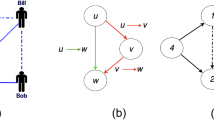Abstract
As we all know, decision-makers need the high quality battlefield information to design the best operation plans, however, real intelligence data are often incomplete and noisy, where missing links prediction methods and spurious links identification algorithms can be applied. Military organizations could be modeled as heterogeneous complex networks, where nodes represent different types of functional units and edges denote different types of communication links. In this paper, we proposed a combined link prediction index considering both the nodes’ types effects and their structural similarities, and demonstrated that it is remarkably superior to all the 25 existing similarity-based methods both in predicting missing links and identifying spurious links in a real military network data; we also investigated the algorithms’ robustness under noisy environment, and showed our method maintained the best performance under the condition of small noise. In the end, as the FINC-E model, here used to describe the heterogeneous military organizations, is also suitable to many other social organizations, such as criminal networks, business organizations, etc., thus our method has its prospects in these areas for many tasks, like detecting the underground relationships between terrorists, predicting the potential business markets for decision-makers, and so on.
Access this chapter
Tax calculation will be finalised at checkout
Purchases are for personal use only
Similar content being viewed by others
References
Alberts, D.S., Garstka, J.J., Hayes, R.E., Signori, D.A.: Understanding information age warfare. Technical report, DTIC Document (2001)
Alberts, D.S.: The Agility Advantage: A Survival Guide for Complex Enterprises and Endeavors. DoD Command and Control Research Program, Washington, D.C (2011)
Cares, J.: Distributed Networked Operations The Foundations of Network Centric Warfare. iUniverse, Bloomington (2006)
Dekker, A.: Applying social network analysis concepts to military C4ISR architectures. Connections 24(3), 93–103 (2002)
Dekker, A.H.: C4ISR architectures, social network analysis and the FINC methodology: an experiment in military organisational structure. Technical report, DTIC Document (2002)
Dekker, A.H.: Network topology and military performance (2005)
Dekker, A.H., et al.: C4ISR, the FINC methodology, and operations in urban terrain. J. Battlef. Technol. 8(1), 25 (2005)
Getoor, L., Diehl, C.P.: Link mining: a survey. ACM SIGKDD Explor. Newslett. 7(2), 3–12 (2005)
Hanley, J.A., McNeil, B.J.: The meaning and use of the area under a receiver operating characteristic (ROC) curve. Radiology 143(1), 29–36 (1982)
Hayes, R.E.: Measuring command and control (c2) effectiveness. In: MORS Workshop-joint Framework for Measuring C2 Effectiveness. Citeseer, Laurel, MD (2012)
Holland, P.W., Laskey, K.B., Leinhardt, S.: Stochastic blockmodels: first steps. Soc. Netw. 5(2), 109–137 (1983)
Hutchins, C.E., Benham-Hutchins, M.: Hiding in plain sight: criminal network analysis. Comput. Math. Organ. Theory 16(1), 89–111 (2010)
Lin-yuan, L.: Link prediction on complex networks. J. Univ. Electron. Sci. Technol. China 39(5), 651–661 (2010)
Lü, L., Zhou, T.: Link prediction in complex networks: a survey. Physica A 390(6), 1150–1170 (2011)
Lü, L., Zhou, T.: Link Prediction. Higher Education Press, Beijing (2012)
Meyer, M., Zaggl, M.A., Carley, K.M.: Measuring CMOTs intellectual structure and its development. Comput. Math. Organ. Theory 17(1), 1–34 (2011)
Shang, M.S., Lü, L., Zeng, W., Zhang, Y.C., Zhou, T.: Relevance is more significant than correlation: information filtering on sparse data. EPL (Europhys. Lett.) 88(6), 68008 (2010)
Sharpanskykh, A., Stroeve, S.H.: An agent-based approach for structured modeling, analysis and improvement of safety culture. Comput. Math. Organ. Theory 17(1), 77–117 (2011)
Tong, H., Faloutsos, C., Pan, J.Y.: Fast random walk with restart and its applications (2006)
Yang, G., Zhang, W., Xiu, B., Liu, Z., Huang, J.: Key potential-oriented criticality analysis for complex military organization based on finc-e model. Comput. Math. Organ. Theory 20(3), 278–301 (2014)
Zhang, P., Wang, X., Wang, F., Zeng, A., Xiao, J.: Measuring the robustness of link prediction algorithms under noisy environment. Sci. Rep. 6 (2016)
Acknowledgements
The authors are grateful to the anonymous referees for their insightful suggestions and comments. This research was supported by the National Basic Research Program of China under Grant No. 71471176, No. 71471174 and No. 61303266. All authors acknowledge the National University of Defense Technology.
Author information
Authors and Affiliations
Corresponding author
Editor information
Editors and Affiliations
1 Electronic supplementary material
Below is the link to the electronic supplementary material.
Rights and permissions
Copyright information
© 2016 Springer Nature Singapore Pte Ltd.
About this paper
Cite this paper
Fan, C., Liu, Z., Xiu, B., Yu, L. (2016). Missing and Spurious Interactions in Heterogeneous Military Networks. In: Li, Y., Xiang, G., Lin, H., Wang, M. (eds) Social Media Processing. SMP 2016. Communications in Computer and Information Science, vol 669. Springer, Singapore. https://doi.org/10.1007/978-981-10-2993-6_2
Download citation
DOI: https://doi.org/10.1007/978-981-10-2993-6_2
Published:
Publisher Name: Springer, Singapore
Print ISBN: 978-981-10-2992-9
Online ISBN: 978-981-10-2993-6
eBook Packages: Computer ScienceComputer Science (R0)




